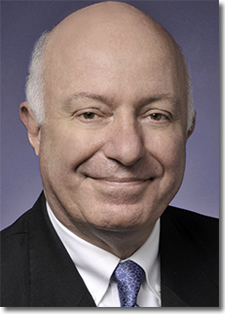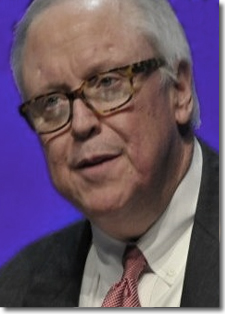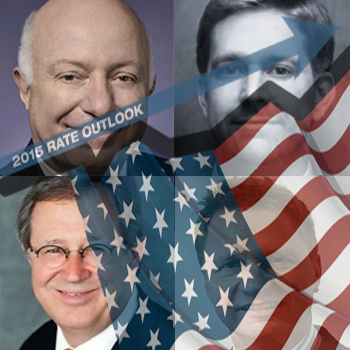New forecast data from the Institute for Supply Management (ISM) suggests that U.S. logistics managers may expect more new business in the coming year.
And while there are many reasons to be optimistic about the outlook for the U.S. and certain global economies, there are also reasons to be concerned.
The U.S., United Kingdom, and India are bright spots, but other key economies are showing signs of stress, says Chris Christopher, Jr., director of consumer economics at IHS Global Insight. “The calendar points to cooling in the Northern Hemisphere, but so far U.S. manufacturing has not paid any attention to the message,” he adds.
IHS Chief Economist Nariman Behravesh is even more bullish, noting that the U.S. economy - the world’s largest - is the “locomotive of global growth” for the first time since the Great Recession.
“The pendulum seems to have swung back from an environment in which, just five years ago, emerging markets were the darlings of the global economy,” says Behravesh. “While the locomotive role of the U.S. is less powerful than it was a couple of decades ago, it has certainly regained its role as the major driver of global growth.”
Though strengthening domestic demand is propelling the U.S. expansion, international trade is still a drag on the economy, a factor that Behravesh says is helping economies in the rest of the world.

The diverse nature of U.S. imports, Behravesh adds, has an impact on a large group of countries, developed, and emerging alike. “Oil and gas production in the U.S. has surged about 30 percent since 2010, spurring job growth, providing a competitive stimulus to manufacturing, an inflow of foreign investment, and a much smaller drag from trade,” he says.
Additionally, Behravesh observes, there are also significant benefits to the rest of the world. Rising U.S. production is a major force in stabilizing global energy markets, offsetting turmoil and disruptions caused by conflicts in Syria, Iraq, Libya, and between Russia and Ukraine. Increased domestic oil production in the U.S. has also been a major factor in driving down the cost of petroleum.
The implications for future shipping rate structures will obviously reflect pressures felt in the global marketplace.
Furthermore, maintain economists, rates will mirror the Federal Reserve as it has offered a strong signal that it was on track to raise interest rates sometime this year.
This alters a pledge to keep rates near zero for a considerable time in a show of confidence in the U.S. economy.
And just what this does for shippers’ “confidence” will be addressed over the next few pages by the same prominent industry experts who delivered a spot-on forecast in 2014. Rates will rise across all modes, they say - but shippers forewarned are forearmed.
Energy Shift
Derik Andreoli, Ph.D.c., senior analyst at Mercator International LLC and Logistics Management’s Oil and Fuel columnist, notes that the biggest story in the energy sector has to be the 30 percent decline in oil prices since June to a level not seen since the global recession cut a whopping 6 percent from global consumption back in 2009.

“This price decline has come as a result of surging U.S. oil production and the fact that global demand has lagged on the back of a significant deceleration in the growth rate of Chinese demand,” says Andreoli.
Unfortunately for consumers of diesel fuel, the extreme softening of global oil prices has not translated to U.S. pump prices. The national average price for a gallon of diesel declined by only 5 percent in the Rocky Mountain region and just 7 percent on the West Coast. While prices have declined by a greater amount in the Northeast, the declines there were from highs associated with the “Polar Vortex” that rocked the region in the first quarter.
“Speaking of the Polar Vortex,” says Andreoli, “natural gas prices are up nearly 20 percent from last year levels, and this is largely the result of the nearly unprecedented surge in demand last winter that pulled natural gas inventories down to a cyclical low that was just half the prior five-year low.”
He adds that inventories have grown faster than normal, but at the end of the “build season,” volumes remain nearly 10 percent below the prior five-year low. “If this winter is particularly bad on the East Coast, we will see prices rise significantly, just as they did between January and March,” adds Andreoli.
So, should U.S. shippers expect another jumpy 12 months for the energy sector? “I don’t think so,” says Andreoli. “The fundamentals of supply and demand strongly suggest that there will be less variability in petroleum prices this year than last. On the one hand, prices almost certainly won’t continue to decline like they have over the last six months, and it was this downward movement in prices that has driven recent activity.”
On the other hand, Andreoli says that there would need to be a significant supply disruption to drive pricing on the upside. This is because surplus production capacity - the ability to “open the tap” - is finally out of the red-zone, and a somewhat comfortable cushion has developed.
“Thus, even a relatively significant change could be managed without dipping back into the red-zone, which seems to be somewhere around 1.5 percent of global liquid fuels consumption,” adds Andreoli. “We’re currently around 3 percent.”
TRUCKING: Tightening Circumstances
But even a major decline in fuel prices will not keep trucking rates from climbing this year, says Stifel Nicolaus analyst John Larkin. Provided the economy continues to grow at an annualized rate of 2 percent or more, it’s projected that supply and demand should further tighten across the trucking industry in 2015.

“Rates should take another healthy low- to mid- single digit jump,” says Larkin. “As the decade develops, shippers may long for such modest rate increases, as the full implementation of electronic logging devices and speed limiter regulations will effectively reduce trucking industry productivity while other driver specific regulations will further reduce the size of the driver workforce.”
According to Larkin, shippers willing to work with carriers to optimize equipment utilization will have the best chance of mitigating rate increases in 2015. He says that carriers are often willing to trade quicker turns of their equipment and drivers for no rate increase. “Sadly, some carriers suggest that only about 20 percent of shippers were willing to collaborate in such a way during 2014,” says Larkin. “Hopefully that percentage will increase in 2015.”
Collaboration between railroads and truckers will continue, however, as both parties would rather not compete on freight moving in long-haul, high-density freight lanes. “Truckers will preserve precious drivers and expensive power units for freight that cannot move economically on the nation’s rail intermodal network,” says Larkin. “Meanwhile, intermodal will continue to handle some truckload overflow as railroads hustle to build and supply more capacity within the northern third of their networks.”
RAIL/INTERMODEL: Permanent Volatility
That continued intermodal/trucking collaboration has been a benefit for the shippers who’ve been able to take advantage to it, says Brooks Bentz, a supply chain management consultant, who notes that intermodal rates have continued to increase, but not very much.

“For shippers, this can be a conundrum when service and capacity issues are prevalent,” says Bentz. “Ramp congestion, chassis shortages, and driver issues on the dray side have forced shippers to increase transit-time expectations or reset cutoff times without commensurate rate decreases.”
Furthermore, says Bentz, the words “rate” and “relief” are not likely to be used in the same sentence for the foreseeable future. “The carriers are more savvy than ever and are also in need of solid earnings so they can continue to invest to improve network capacity and performance,” he says, adding that volume growth is predicted to continue unabated and all reliable forecasts indicate that there will be a capital shortfall in meeting demand.
“This means rates will need to rise and profits will need to improve,” says Bentz. “If they don’t, the network congestion we’re currently seeing will certainly worsen.”
Margaret Tedlie, a former Accenture analyst who is now senior director of indirect procurement for Crocs, Inc. concurs. “It’s a very challenging time for shippers across all modes of transport,” she says. “The ‘perfect storm’ fiasco of last winter started a tsunami of problems that, for intermodal in particular, have not all been resolved.”
While the rail network never fully recovered from last winter’s issues, not much stays the same for long, adds Tedlie. She maintains that “permanent volatility” is an apt phrase for what shippers may expect to face in the future. “The key to answering the challenges of permanent volatility are embodied in creating agile, flexible supply chains that can respond quickly to changing environments,” adds Tedlie.
But given the current seaport disruption on the U.S. West Coast, will there be a sudden shift in rail and intermodal strategies? Tedlie says the impact has not been material - not yet.
“Some shifting to truck has occurred due to reliability issues, but the higher costs tend to push the volume quickly back to rail,” says Tedlie. “All-water routes may eventuate, but bear in mind that slow-steaming and super slow-steaming have already lengthened supply chains, so mini-bridge and micro-bridge is still the best operating model, particularly when trans-loading is used at the West Coast ports.”
OCEAN: Carrier Discipline
Martin Dixon, research manager for the London-based consultancy Drewry Supply Chain Advisors, does not agree entirely with Tedlie’s assessment noting that, in the long term, shippers will be hedging their bets with port selection.

“We expect U.S. port congestion to remain an issue with cost implications for shippers,” says Dixon. “Moreover, the deployment of ever-larger vessels, chassis shortages, and intermodal network service problems will continue to create landside congestion issues for ports.”
Pricing analysts for Drewry are expecting the recent spate of freight rate spikes to continue. In fact, they’re forecasting that the trade will not return to supply-demand equilibrium until 2017 at the earliest.
“In the meantime, carriers will continue to be challenged by overcapacity and are expected to prolong their well-tried practice of skipped sailings and frequent general rate increases in an attempt to prevent freight rate erosion,” says Dixon. “Hence the market will remain highly excitable for some time to come.”
Drewry says carriers have proven more disciplined recently with their capacity deployment at a trade route level. Throughout much of 2014, load factors remained relatively high on the main headhaul East-West trades, and analysts expect this practice to continue.
“However, with many of the newly-built mega-vessels due to enter the trade in 2015, carriers will be challenged to maintain this discipline,” says Dixon. “We expect North-South trades [those serving Latin America, Africa and Oceania] to be affected by further cascading of vessel capacity and pressure on freight rates.”
Labor disruptions on the U.S. West Coast have given shippers reason to rethink their sourcing strategies, too, says Dixon. Along with most other maritime analysts, he believes a long-term trend to “spread the risk” by using multiple ports is likely.
AIR: Capturing Share
The disruptive activity at Pacific Rim ports was helping air cargo recover, too, says Chuck Clowdis, managing director of transportation advisory services for IHS Global Insight.

“Many retailers dependent on the West Coast ports were forced to fly their goods late last year due to congestion issues,” says Clowdis. “Air carriers also benefited by restored levels of consumer confidence, which released pent-up demand. Manufacturers also are generally more up-beat about demand and production than a year ago.”
But carrier’s reluctance to fill and manage existing capacity continues to be a concern, says Clowdis. The long lag in past profit cycles eroded confidence and slowed sufficient planning.
“To employ a well-worn cliché, we are ‘cautiously optimistic,’” says Clowdis. “And now is the time for shippers to lock in rates for at least a year. As long as the recovery is steady, rather than roller coaster-like, carriers will be willing to work with shippers to assure capacity and rates for through 2016.”
Analyst at Boeing are taking an even longer view, forecasting air cargo traffic to grow at an annual rate of 4.7 percent over the next 20 years, with global air freight traffic expected to more than double by 2033.
“We see strong signs of a recovery as air freight traffic levels continue to strengthen after several years of stagnation,” says Randy Tinseth, vice president of marketing for Boeing Commercial Airplanes. “The air cargo market is now growing at nearly the long-term rates.”
World air cargo traffic began to grow again in the second quarter of 2013, with growth reaching 4.4 percent for the first seven months of 2014, compared to the same period a year earlier. If this trend continues, 2014 will be the highest growth year for the airfreight industry since 2010.
PARCEL: Duopoly Rules
While most of the other modes seem systemically dysfunctional when it comes to generating new revenue, not so with express parcel carriers. This vital sector manages to raises rates every year for one simple reason - they can.

“Over the last few years, UPS has been increasing its domestic air parcel express at an accelerated rate, so as to decrease the difference between their base rates and those of FedEx,” says Jerry Hempstead, president Hempstead Consulting. “Now the difference is imperceptible, although it’s still present.”
Of far greater import to shippers is the difference between the fuel surcharge charged by FedEx - currently 6 percent for both air and ground - and the fuel surcharge applied by UPS - 8 percent for ground and 13 percent for air.
According to Hempstead, this is a huge difference that gets lost in the noise of the complexities of rate making. “Shippers will be seeing much improved fuel surcharges in the first quarter due to the lag in the price paid for fuel today and the setting of fuel surcharges two months from now,” he says. “This should help mitigate some of the price shock of the tariff increases, although the carriers can change the fuel surcharge tables at any time without notice.”
But Hempstead contends that shippers should consider a third alternative for lightweight parcels in this era of e-commerce and the rise of business-to-consumer transactions. “The menu of services provided by the USPS is worth examining,” he says. “Unlike UPS and FedEx, the USPS announced a price decrease in September for some of its services and no increase planned at this time for parcels at least in the near term.”
Hempstead says that some shippers are using the USPS Regional Flat Rate Priority Mail boxes and getting better service and lower cost than ground transactions with the integrators, adding that it would be wise for shippers to enter into conversations with the USPS sales representative.
“Rate increases with any carrier are negotiable,” Hempstead adds using a familiar trope. “Rule changes like current dimensionalization, along with future delivery-area surcharges, residential fees, address corrections, and fuel surcharges are negotiable. You don’t get what you deserve as a shipper - you get what you negotiate.”
On The Record Interview with Gary Shilling

In this interview Dr. Gary Shilling, provides an economic update and answers the question of whether or not we’re in a full fledged economic recovery. He discusses what’s happening with imports and exports, what type of growth we should expect for the next several years, and more.
Listen to the interview to get a better idea of where we’re at currently and how the new year may unfold.
2015 Rate Outlook Webcast

Where are your freight transportation rates headed?
Thursday, January 29, 2015 | 2 pm ET
Register Now!
About the Author
Follow Robotics 24/7 on Linkedin
Article topics
Email Sign Up

















